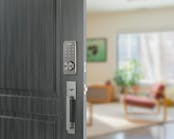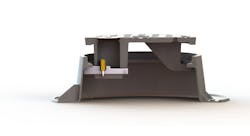As the demand for electronic access control continues to increase in both the home and in commercial settings, many locksmiths are beginning to expand their product offerings to provide options and solutions beyond just the mechanical locks they may have worked solely on in the past.
Joshua Sands, owner of Key City Locksmith and Security in Kansas City, Mo., and vice-president and director of education for the Missouri-Kansas Locksmith Association, says in the past he had to recommend electronic solutions, but now customers are asking for it, which is a big shift.
“I used to have to be the one to try and upsell, or say, ‘by the way, did you know we can also do this,’ but now the common commercial customer seems to know some of the electronic solutions that are available to them,” says Sands. “We've gone from them not knowing to them knowing about it, and now we're seeing probably about a 20- to 30-percent increase of actually closing those electronic sales.”
In addition, Sands says electronic access reduces wear on and increases the life of cylinders and keys, noting that customers see that “as a better selling point for their budget than anything along the convenience line,” he points out. “It's becoming quite common when I go to do a $100 rekey, for example, that it turns into a couple of thousand in electronic access control instead.”
As Sands notes, electronic access control jobs generate more revenue than just mechanical work, not to mention recurring revenue options.
“We do on average at least a three to four times markup on the electronic access because there is so much more involved,” he explains. “We need to determine if they already have a building that's prewired for this stuff, or do we have to go in and wire up the strike through the frame, through the wall, over to where it's going to be controlled? And then we also have a higher cost on materials because an $100 commercial lever now costs $300 or $400 because there's electronic components built inside of it.”
Getting Started
Sands started about 12 years ago as a locksmith doing mechanical work for both residential and commercial, but quickly saw the need for electronic access work, which has accelerated in the past five years.
“We do things from standalone keypad systems all way up to fully integrated maglocks, electronic locking hardware integration with smart apps and analytics that can tell you who, what and when somebody came around … we can do auto locking/unlocking, for example,” says Sands. “We personally are not fire certified, so we don't tie into fire systems, but we do refer out to fire alarm companies in the area to tie in and become compliant with the code.”
When he first started out, Sands says he saw more keypad requests on the residential side because it was “the cool, hip thing to do – nobody wanted to carry keys anymore,” he points out. “Commercial didn't really want to see that spend, but as the years went on, I'd say within at least the last five years, keypads on the commercial space have become a lot more budget friendly.”
In addition, he says IT and loss prevention departments are seeing the need for an audit trail, or at least quick removal of credentials instead of calling out a locksmith and rekeying a whole building. “Now we can just change a keypad and that's a lot quicker and more affordable, so the commercial industry has really picked up in the last five years or so just on these standalone access control devices,” he says.
Add to that retail locations, multifamily, vacation properties and rentals or hybrid offices and spaces, the need for electronic access control is growing exponentially.
“They need electronic access control so that people can badge in and out whenever, and customers today feel it's a lot easier than using physical keys,” says Sands. “I don't think it'll ever replace physical security, because if something fails on the electronic side, as with all electronics, you're still going to need a backup. But it is quickly becoming one-to-one between physical and electronic security. So, for every new locking hardware, such as a physical key and knob or key and exit device in the commercial space, we are also getting the same request for what it would cost to make it electrified.”
Recurring Revenue
Once a locksmith has installed an electronic access control system, there are numerous possibilities to earn recurring revenue, and as Sands points out, it adds up as you start amassing customers. Key City offers some type of warranty depending on the product, which provides the customer with peace of mind that there will be support beyond just the installation.
“We are all about recurring revenue,” Sands says, noting that depending on the system, he is seeing approximately $30-$40 per month in recurring revenue based on the warranty, which may include upkeep and maintenance of systems, much of which can be done remotely.
“It may be a minimum cost, but over the year that's an extra $300 to $400 per customer,” he notes. “Now if I get 10 more customers that do that – that's $3,000 to $4000 per year extra for hopefully doing nothing if there are no major issues, and if you’ve done a good job, there usually isn’t. And with both residential and commercial, having that remote capability to be able to jump in quick, send the customer an authorized email that they can give us access to their system remotely and they can tell the system how long they want us in there – they like that convenience, control and security, and it also helps prevent us from rolling a truck.”
Mobile, Cloud and Data Analytics
The commercial side of the business continues to embrace mobile credentials, and the use cases continue to multiply across verticals. “It falls under audit trails and ease of removing a credential when an employee leaves or gets fired … instead of us rekeying an entire building, now we only have to change out five codes on five doors, or maybe they're smart enough on their end that they can handle this themselves, and they don't even call us at all,” he says.
While some customers are still a bit wary of putting everything in the cloud, the emergence of analytics, machine learning and AI is paving the way for more use cases involving the mining and leveraging of data, as well as using real-time information to make more informed decisions.
Sands uses the example of today’s high-end cameras with gunshot detection, noting that there are many benefits of being able to use the cloud-computing power to help with many aspects of security and operational readiness and emergency response, if needed.
“The cloud is very important and beneficial because that's what allows us to have these smart analytics,” he explains. “If the camera detects what it thinks is a gunshot, not only does it detect that that frequency of sound is close enough to a gunshot, but it also tells us approximately how far away from that camera it is. And if you have multiple cameras in the area, you can triangulate where it's coming from. The second part is now we've got smart analytics with this, and these cameras can tie into your locking system. If it detects a gun shot, it can automatically put the school on lockdown.”
There are also tons of benefits beyond just security if the customer wants to leverage the data with analytics.
“The whole commercial industry is all about the data we can leverage by utilizing the cameras and the alarm system together with advanced software,” he explains. “No more checking in or clocking in and out of work. The camera is set up to pick up human detection and knows that right around 8:00 a.m. is when Tim is supposed to come to work, so at 7:57, when the camera detects that's Tim's face, for example, he's clocked in for the day.”
High Security
In addition, Sands is seeing a demand for high security in conjunction with electronic access for audit trail capabilities.
“Not only do you have to have a UL 437 physical key on important areas of the hospital, but now they also have a camera watching it with certain number of hours of backup,” he explains. “The cannabis industry is another good example, as you need to have to at least a restricted level key in most jurisdictions that I have researched. Plus, camera systems that watch these certain areas for anywhere from 72 hours up to two weeks of recording. There are some states that are very high on that recording time. This is great for us because that's a lot of money to save that data, but it gets quite cumbersome trying to find the logistics of how to get two to four weeks of recording into a place that doesn't take up a whole mainframe.”
Looking big picture, Sands see an increase in smart cities, and points to projects like Millennium Park in Chicago where cameras and systems were installed, noting that similar projects are popping up in cities across the U.S., in addition to small businesses and homes embracing new technology.
“We've done such a great job in just 15 years of going from detecting strange bags and things that may be a threat to making our life so much easier and safer,” he says. “Now we're coming down to the small mom and pop shops that want their keypad access and cameras, and we can implement all this smart technology to make their lives easier.
“I cannot wait to see where we go with this technology.”
Note: This is the first in a multi-part series on “upgrading to electronics.”
Paul Ragusa | Senior Editor
Paul Ragusa is senior editor for Locksmith Ledger. He has worked as an editor in the security industry for nearly 10 years. He can be reached at [email protected].






